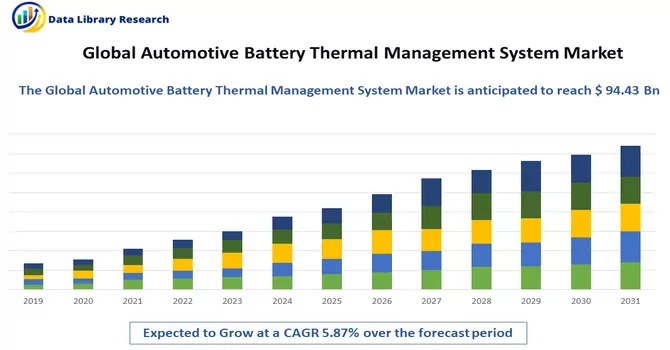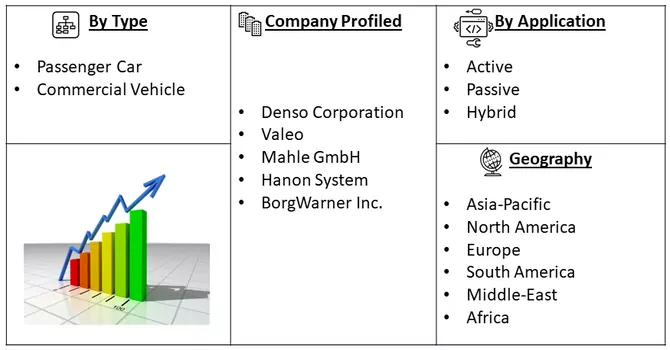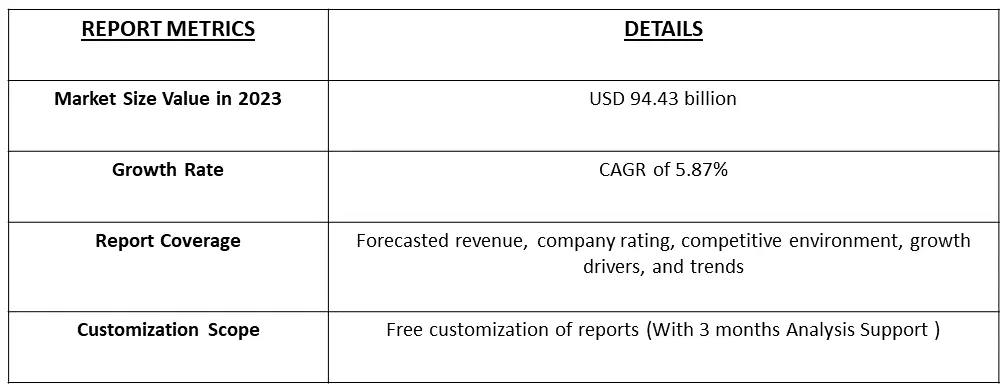The Automotive Thermal Management Market is currently valued at USD 94.43 billion in 2023 registering a CAGR of 5.87% during the forecast period (2023-2030).

Get Complete Analysis Of The Report - Download Free Sample PDF
Automotive thermal management refers to the systems and technologies used in vehicles to regulate and control the temperature of various components and systems. It is a crucial aspect of vehicle design and operation because temperature control is essential for the efficient and safe operation of various automotive systems. Automotive thermal management involves managing both heat generation and heat dissipation within a vehicle.
The rising need for better ride quality and heat insulation for cabin comfort is greatly emphasized in the automotive industry, leading to a much higher demand for thermal management systems. The ever-increasing number of electrical and electronic components inside vehicles also drives the need for better thermal management systems due to heat dissipation.
The shift towards electric and hybrid vehicles has placed a significant emphasis on battery thermal management. Advanced cooling and heating systems for batteries have been a focal point to optimize performance, range, and longevity. Moreover, automakers have been focusing on improving the overall efficiency of thermal management systems. This includes more efficient radiators, coolants, and heat exchangers to reduce energy consumption and enhance fuel economy. Thus, the market is expected to witness significant growth over the studied period.
Segmentation:
The Global Automotive Thermal Management System Market is segmented by Application (Engine Cooling, Cabin Thermal Management, Transmission Thermal Management, Waste Heat Recovery/Exhaust Gas Recirculation (EGR) Thermal Management, Battery Thermal Management, and Motor and Power Electronics Thermal Management), Vehicle Type (Passenger Car and Commercial Vehicle), and Geography (North America, Europe, Asia-Pacific, and Rest of the World). The report offers the market size in value (USD Billion) and forecasts for all the above segments.

For Detailed Market Segmentation - Download Free Sample PDF
Drivers
Climate Control and Passenger Comfort and Battery Thermal Management
The climate control, passenger comfort, and battery thermal management are integral aspects of modern automotive design. The automotive thermal management market is evolving to meet the demands of consumers and automakers, with a particular focus on improving energy efficiency, optimizing temperature control, and extending the life of electric vehicle batteries. These trends are likely to continue as the automotive industry moves towards increased electrification and sustainability. Further, the launch of new products by key market players is contributing to the growth of the studied market. For instance, in March 2022, Hanon Systems inaugurated a new plant located in Huchai, China, to manufacture heating, ventilation, and air conditioning (HVAC) modules for electrified vehicles. Thus, the market is expected to witness significant growth over the forecast period.
Advancements in Materials and Technologies
The ongoing developments in materials and thermal management technologies, including heat exchangers, coolants, and insulation materials, are driving efficiency improvements in thermal management systems. For instance, Apr 2022: Denso Corp. won contracts to supply Toyota and Subaru’s all-new, all-electric bZ4X and SOLTERRA with key electrification components, including thermal management systems like heat pump systems and radiant heating systems. Toyota electric bZ4X will be launched in May 2022, while Subaru SOLTERRA was expected to debut in mid-2022. Similarly, in Apr 2022, Hanon Systems announced to relocation of its manufacturing facility in Turkey from Gebze to Dilovasi.
Restraints
High Development Costs and Complexity in Electric Vehicles
Developing and implementing advanced thermal management systems in vehicles can be expensive. Research, development, and testing of new technologies and components can significantly add to the overall cost of manufacturing vehicles. Also, electric vehicles (EVs) require sophisticated thermal management systems to maintain optimal battery temperature and overall vehicle efficiency. This complexity can pose challenges in terms of design, integration, and cost. Thus, these factors may slow down the growth of the studied market.
Segmental Analysis:
Battery Thermal Management Segment is Expected to Witness Significant Growth Over the Forecast Period
The growing popularity of all-electric and hybrid vehicles has created a strong demand for battery thermal management systems. These systems are essential to maintain batteries at optimal temperatures for efficient charge storage and utilization. As a result, the automotive thermal management market is expected to experience substantial growth in the coming years. For instance, in 2021, several European countries reported double-digit growth in electric vehicle (EV) sales, contributing to Europe's capture of approximately 34% of global EV sales, compared to 43% in 2020. The overall sales of plug-in vehicles reached 2.27 million units in 2021, a significant increase from 1.37 million units in 2020.
This surge in sales can be attributed to the implementation of stricter emission regulations by various governmental and organizational bodies, promoting the adoption of zero-emission vehicles. Furthermore, automotive companies are actively investing in developing more efficient battery solutions tailored for upcoming battery electric vehicles (BEVs). For example, in September 2022, Mahle introduced advanced thermal management systems designed specifically for commercial electric vehicles, showcased at the IAA Transportation event in Hannover, Germany. These developments and trends are expected to have a substantial impact on the automotive thermal management market, driving its expansion significantly during the forecast period.
Commercial Vehicle Segment is Expected to Witness Significant growth over the Forecast Period
Automotive thermal systems are crucial for the efficient and safe operation of commercial vehicles. These systems must be tailored to the specific requirements and usage patterns of commercial vehicles, which can vary widely based on the type and intended application of the vehicle. As the commercial vehicle sector continues to evolve, so too will the technology and solutions in automotive thermal management for these vehicles. Commercial vehicles typically have larger and more powerful engines than passenger cars, generating higher heat loads. Effective engine cooling systems, including radiators and fans, are essential to prevent overheating and maintain engine efficiency. Thus, the segment is expected to witness significant growth over the forecast period.
The Asia-Pacific region is Expected to Witness Significant growth over the Forecast Period
The Asia-Pacific region, characterized by the booming automobile sector and the emergence of India and China as major manufacturing hubs for Western automotive giants, is poised to drive the market for thermal management systems in this part of the world. The region's automotive industry is experiencing significant growth, propelled by government regulations that promote the adoption of electric vehicles (EVs) and the expansion efforts undertaken by original equipment manufacturers (OEMs) and suppliers, particularly in China. For instance, in August 2022, Schaeffler Group marked a milestone by producing five million thermal management modules in China, highlighting the region's importance in automotive manufacturing. India, as the world's fourth-largest automotive market, has also witnessed substantial growth, especially in the commercial vehicle segment, where it ranks seventh globally. The Indian auto component sector has seen a notable expansion in recent years. For example, in March 2022, Matter, a technological innovation startup based in Ahmedabad, unveiled a high-speed mid-torque electric motor known as Matter Drive 1.0 Motor. This intelligent drivetrain incorporates breakthrough features, including the Integrated Intelligent Thermal Management System. Furthermore, the Asia-Pacific region is experiencing a surge in sales of electric and hybrid vehicles in countries like China, India, Japan, and South Korea. This trend is expected to further boost the market for automotive thermal systems in the region. As a result, the Asia-Pacific region is anticipated to maintain its status as the largest market for automotive thermal systems globally throughout the forecast period.

Get Complete Analysis Of The Report - Download Free Sample PDF
The automotive thermal management market is moderately consolidated, with the major players dominating the market. Some of these players include
Recent Developments:
1. In November 2022, Denso Corp. launched a new LD9 electric zero emissions thermal management unit for buses and coaches at the Bus & Coach Expo in Sydney, Australia.
2. In March 2022, Hanon Systems inaugurated a new plant located in Huchai, China, to manufacture heating, ventilation, and air conditioning (HVAC) modules for electrified vehicles.
Q1. What is the current Automotive Battery Thermal Management System Market size?
The Automotive Thermal Management Market is currently valued at USD 94.43 billion in 2023.
Q2. What is the Growth Rate of the Automotive Battery Thermal Management System Market?
Automotive Battery Thermal Management System Market registering a CAGR of 5.87% during the forecast period.
Q3. Which region has the largest share of the Automotive Battery Thermal Management System Market? What are the largest region's market size and growth rate?
Asia-Pacific region has the largest share of the market . For detailed insights on the largest region's market size and growth rate request a sample here.
Q4. What segments are covered in the Automotive Battery Thermal Management System Report?
By Application, By Vehicle Type & Geography are the segments are covered in the Automotive Battery Thermal Management System Report.
Data Library Research are conducted by industry experts who offer insight on industry structure, market segmentations technology assessment and competitive landscape (CL), and penetration, as well as on emerging trends. Their analysis is based on primary interviews (~ 80%) and secondary research (~ 20%) as well as years of professional expertise in their respective industries. Adding to this, by analysing historical trends and current market positions, our analysts predict where the market will be headed for the next five years. Furthermore, the varying trends of segment & categories geographically presented are also studied and the estimated based on the primary & secondary research.
In this particular report from the supply side Data Library Research has conducted primary surveys (interviews) with the key level executives (VP, CEO’s, Marketing Director, Business Development Manager and SOFT) of the companies that active & prominent as well as the midsized organization
FIGURE 1: DLR RESEARH PROCESS

Extensive primary research was conducted to gain a deeper insight of the market and industry performance. The analysis is based on both primary and secondary research as well as years of professional expertise in the respective industries.
In addition to analysing current and historical trends, our analysts predict where the market is headed over the next five years.
It varies by segment for these categories geographically presented in the list of market tables. Speaking about this particular report we have conducted primary surveys (interviews) with the key level executives (VP, CEO’s, Marketing Director, Business Development Manager and many more) of the major players active in the market.
Secondary ResearchSecondary research was mainly used to collect and identify information useful for the extensive, technical, market-oriented, and Friend’s study of the Global Extra Neutral Alcohol. It was also used to obtain key information about major players, market classification and segmentation according to the industry trends, geographical markets, and developments related to the market and technology perspectives. For this study, analysts have gathered information from various credible sources, such as annual reports, sec filings, journals, white papers, SOFT presentations, and company web sites.
Market Size EstimationBoth, top-down and bottom-up approaches were used to estimate and validate the size of the Global market and to estimate the size of various other dependent submarkets in the overall Extra Neutral Alcohol. The key players in the market were identified through secondary research and their market contributions in the respective geographies were determined through primary and secondary research.
Forecast Model
